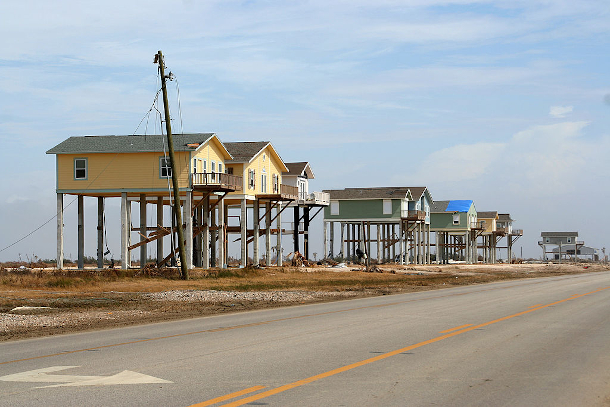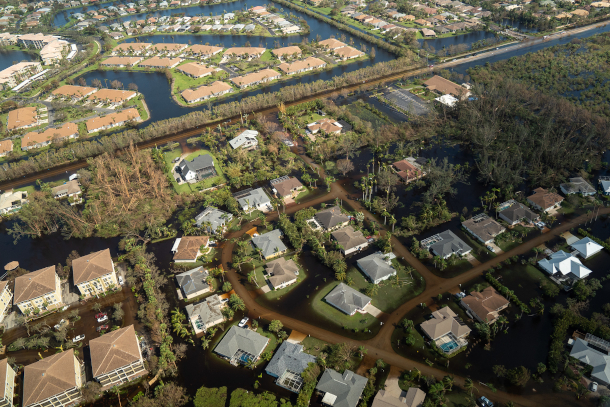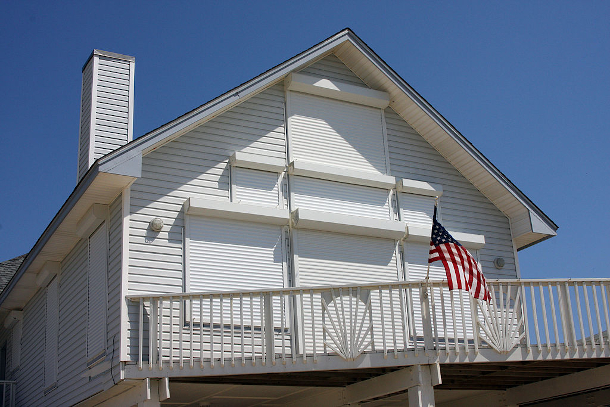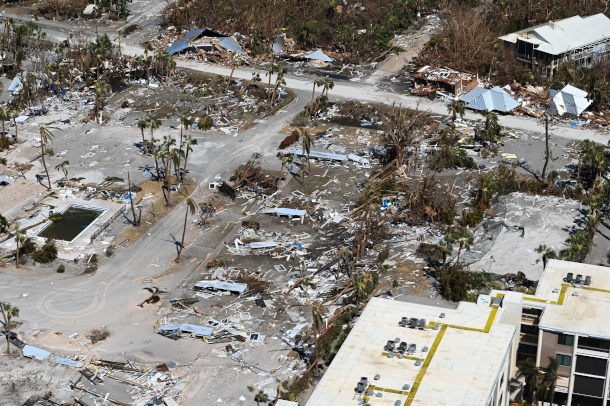Building Codes and Hurricane Resilience
Air Date: Week of October 14, 2022

Bolivar Peninsula, TX, October 15, 2008 -- Elevated houses along Highway 87 survived Hurricane Ike's twenty-foot storm surge with minimal damage. Homes that were not elevated in this area did not survive the hurricane. (Photo: Greg Henshall / FEMA, public domain)
Hurricane Ian brought a powerful storm surge and 155-mile-per-hour winds that destroyed or severely damaged many homes. But some homes in the direct path of the hurricane were left intact and mostly unharmed thanks to the strong doors, windows, and roofs mandated by newer building codes. Nicholas Rajkovich is a University at Buffalo professor in the Department of Architecture and joins Host Bobby Bascomb to talk about how to build more hurricane-resistant homes and communities.
Transcript
DOERING: It’s Living on Earth. I’m Jenni Doering
BASCOMB: And I’m Bobby Bascomb
Hurricane Ian brought a powerful storm surge and 155-mile-per-hour winds that wrecked communities like Fort Myers Beach, Florida, sweeping entire homes off their foundations. But some homes in the direct path of the hurricane in places like Punta Gorda were left intact and mostly unharmed. Many of those homes that survived Hurricane Ian did so because they were built or renovated after stronger building codes were put in place in the wake of previous hurricanes. Nicholas Rajkovich is a University at Buffalo professor in the Department of Architecture who studies climate adaptation and resilience in cities and buildings.
RAJKOVICH: The first thing really is to not build buildings in vulnerable locations. So many of the places that we saw in Florida that were wiped out were right along the coast and subject to storm surge, which certainly can be catastrophic. So pulling away from some of those locations and identifying places that are on higher ground, or behind things like sand dunes, or, you know, behind wetlands, those all help to drain stormwater away from these types of storm events. But beyond that, looking at the building codes, we really can start to do things to tie the structure together to make sure that the roof doesn't peel off of the building during high wind events, or that windows and doors aren't blown inward, which can lead to a catastrophic loss of the building.
BASCOMB: So how do you do that, though, because I mean, 155 mile-per-hour winds, that can be really damaging despite your best efforts, I would think. How do you ensure that a building is going to be able to withstand a really powerful storm like that?

Flooded neighborhoods in hard-hit Lee County, Florida in the aftermath of Hurricane Ian. (Photo: South Florida Water Management District, Flickr, CC BY-ND 2.0)
RAJKOVICH: Well, if we look at the building, and we kind of start with the roof down, some of the innovations that people are looking at are using different roofing materials that are more resilient to the high winds. So things like concrete tiles, things that are heavy, that will actually stay in place during those storm events. In some locations they're actually requiring almost a double roof. So even if a few tiles are being peeled back, there's actually a secondary layer that's underneath that, that allows the water to drain. As we move from the roof down to the structure of the building, looking at things like making sure that the roof is actually tied to the walls with different types of metal clips, and those walls are actually tied to the foundation, really brings that whole building together to make sure that you know, no portion of it is actually going to tear off or tear away. Other kind of weak points in the building design are certainly the windows and doors. And since the 1990s, Florida has had some of the strictest codes related to windows and doors to make sure that they're impact resistant. There's been a lot of innovation recently in terms of things like laminated glazing, which is actually putting a sheet of plastic in the glazing to make sure that if something hits it, it's not going to cause that window to fail. But also things like storm shutters, which actually can protect the window, or really making sure that they're anchored to the overall wall so that they can't get blown out. Because again, each one of the small things that can fail during a hurricane, are the things that, believe it or not, can lead to kind of a catastrophic loss of the structure. Just a little bit of wind getting into the building can over pressurize it and cause that kind of progressive failure.
BASCOMB: And I would think that if you're sealing up a building so securely against a hurricane, is it also more energy efficient? You know, you're gonna keep your air conditioning inside better in a place like Florida.
A first look a Punta Gorda, FL this morning as sun rose. #Ian #HurricaneIan @DJIGlobal pic.twitter.com/V3nq0ld9im
— Justin Hobbs (@YourWXJustin) September 29, 2022
RAJKOVICH: Absolutely. So as you tie the structure together and make sure that there's no places for wind to infiltrate the envelope, you're certainly going to save on air conditioning. But in a lot of cases, these houses that have been built since the 1990s were also built to higher energy efficiency standards. So you have kind of a win-win in terms of reducing overall costs, even though you might have higher upfront costs in terms of construction.
BASCOMB: Mmm, it's gonna pay in the long run, both in your utility costs and not having to rebuild when you have the next hurricane.
RAJKOVICH: For sure. And in many cases, these buildings that are built to higher codes, oftentimes have lower insurance premiums because of that.
BASCOMB: Hmm, that makes sense. Well, you know, very often, the most damage from a hurricane is not necessarily the wind, but the storm surge and the flooding that go along with it. How can we design buildings to be more resilient to, you know, several feet of floodwater that some of these places get in some cases?

Galveston, Texas, September 30, 2008 - This house on the beach facing the ocean on the Gulf Coast side of Galveston Island survived Hurricane Ike with minimal damage because of storm shutters and other mitigation measures. (Photo: Robert Kaufmann/FEMA, public domain)
RAJKOVICH: So in a place like Florida, a great example is people elevating their first floor of the building above what the expected flood levels are going to be. And so we see in a lot of traditional housing that kind of raised first floor level that might be six, seven feet above the ground. And those are designed in a way that whatever the expected storm surge might be in a location, it's going to be several feet above what's called the base flood elevation. And in that case, what you're trying to do is make sure that there's no essential equipment on the ground level, but you're also designing the foundation so that even if the storm water or the storm surge goes through it, it's not going to take away the foundation or kind of undercut it in that way. But it's a fairly traditional method that is actually starting to make a real comeback in a lot of coastal communities.
BASCOMB: Yeah, it certainly makes sense. Well, how possible is it to make these retrofits to existing buildings using these improved building codes?

A U.S. Coast Guard Air Station Clearwater MH-60 Jayhawk aircrew conducts overflights along the coast of western Florida in the Sanibel Island and Fort Myers area following Hurricane Ian Oct. 1, 2022. (Photo: U.S. Coast Guard photo by Petty Officer Third Class Riley Perkofski, public domain)
RAJKOVICH: So that is the real challenge. I mean, there's millions of homes in places like Florida and all along the coasts that have not been built to these higher standards. And so it's certainly a significant upfront cost to begin to do that work. What the building codes do have a provision for is if you do a major renovation to a building, and usually it's over a significant dollar threshold, that at that point, you actually need to bring them up to code for things like hurricane uplift or for those new windows and doors that I mentioned before. And so that's really the time, you know, when you can really make these buildings much more resilient. The challenge in communities, especially low-income communities, is that they may not go through those cycles of renovation. And so that's why we're in particular concerned about those communities as they face storms in the future that are strengthened by climate change.
BASCOMB: Well, it seems like there are a lot of different layers of bureaucracy potentially to get through here. You know, there's the state, there's local communities, there's federal government, there's insurance companies. How do you get these different entities to talk to each other in a way that's going to be useful going forward?

Metal roof connector straps help structures withstand hurricane-force winds (Photo: Bill Bradley, Wikimedia Commons, CC BY-SA 3.0)
RAJKOVICH: I think, so that's the, really the million dollar or billion or trillion dollar kind of question. So, you know, as we look at the different policies that are set at the federal level, things like the Flood Insurance Program, that's something that certainly they have a vested interest to make sure that communities are going to be protected, and not face these types of hazards in the future. But also to make sure that that type of program doesn't go broke in the long run, as we have more and more claims. As you move to the state level, you know, we're talking about building codes are oftentimes administered at the state level. And so understanding how we continually update those things in a way that not only gets us the most resilient buildings possible, but also that we don't leave out low-income communities as part of that process. You know, for every dollar that we start to put into increasing the resilience of the building, it also potentially makes those houses unaffordable for people to buy into newer homes or buy into those retrofitted homes. And then at the city and kind of county level, you know, those are the places where we oftentimes are talking about land use and environmental planning. And those are really hyper local decisions about restoration of wetlands, about setbacks from coastal hazards, and things like that. And all of those things need to come together. And I think part of that challenge is getting alignment, you know, getting our congresspeople, getting, you know, local electeds, talking about these issues together to figure out a solution that's really going to benefit the most amount of people. And I, I'm hopeful in saying that I think this is a bipartisan issue. Also, because it's really something that because we all kind of pay into federal storm relief, you know, this is really something that's much more of a national issue that we all have to talk about, as opposed to something that's kind of on a local, city by city scale.
BASCOMB: Well, Nick, scientists tell us to expect more hurricanes going forward. Climate change is exacerbating the conditions that really make them so powerful. What do you see going forward? What are you thinking about in your professional life among your colleagues, trying to be proactive, knowing that this is going to become more of a problem?

Nick Rajkovich researches climate adaptation and resilience in cities and buildings as a professor in the School of Architecture and Planning at the University at Buffalo. (Photo: Courtesy of Nick Rajkovich)
RAJKOVICH: For sure. I mean, we definitely need to be thinking not only how do we adapt our buildings to climate change, so the existing buildings that we have, how do we deal with the higher temperatures, the stronger storms, things like sea level rise, but also how do we make buildings more resilient to extreme events like hurricanes? I think in the last couple of years, there's been a real wake-up call in the architecture, engineering and construction community. And they really see this as being a critical issue going forward. But that hasn't made it into all of our codes and standards yet, we're still tending actually to look at data, that is the last 30 years of data instead of projecting it forward into the future. So thinking through how we're going to design in the long run, and what kind of conditions our buildings will see in the futures is really important because what we build today may still be standing 80 or 100 years in the future, and it's going to be a very different climate that those buildings are facing.
BASCOMB: Nick Rajkovich is a University at Buffalo professor in the Department of Architecture. Nick, thanks so much for taking the time with me today.
RAJKOVICH: Thanks for having me.
Links
About Nicholas Rajkovich’s research on climate change, extreme weather, and the built environment
Learn more about building science and how to protect your home from hazards from FEMA
Living on Earth wants to hear from you!
Living on Earth
62 Calef Highway, Suite 212
Lee, NH 03861
Telephone: 617-287-4121
E-mail: comments@loe.org
Newsletter [Click here]
Donate to Living on Earth!
Living on Earth is an independent media program and relies entirely on contributions from listeners and institutions supporting public service. Please donate now to preserve an independent environmental voice.
NewsletterLiving on Earth offers a weekly delivery of the show's rundown to your mailbox. Sign up for our newsletter today!
 Sailors For The Sea: Be the change you want to sea.
Sailors For The Sea: Be the change you want to sea.
 The Grantham Foundation for the Protection of the Environment: Committed to protecting and improving the health of the global environment.
The Grantham Foundation for the Protection of the Environment: Committed to protecting and improving the health of the global environment.
 Contribute to Living on Earth and receive, as our gift to you, an archival print of one of Mark Seth Lender's extraordinary wildlife photographs. Follow the link to see Mark's current collection of photographs.
Contribute to Living on Earth and receive, as our gift to you, an archival print of one of Mark Seth Lender's extraordinary wildlife photographs. Follow the link to see Mark's current collection of photographs.
 Buy a signed copy of Mark Seth Lender's book Smeagull the Seagull & support Living on Earth
Buy a signed copy of Mark Seth Lender's book Smeagull the Seagull & support Living on Earth

